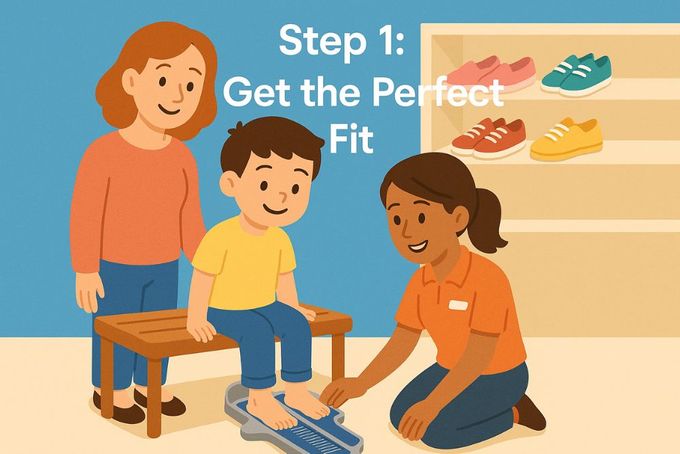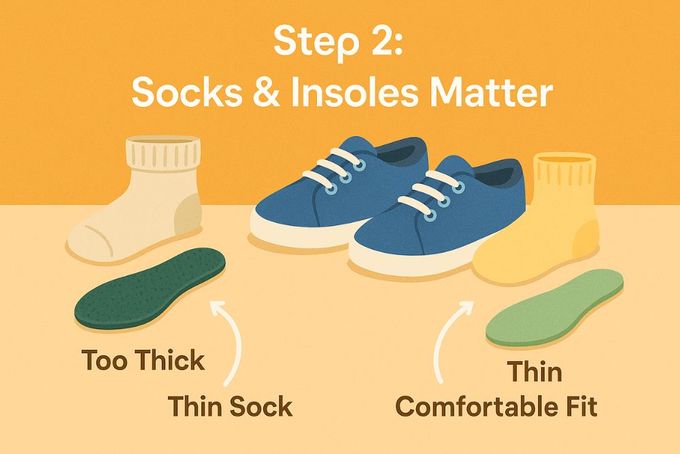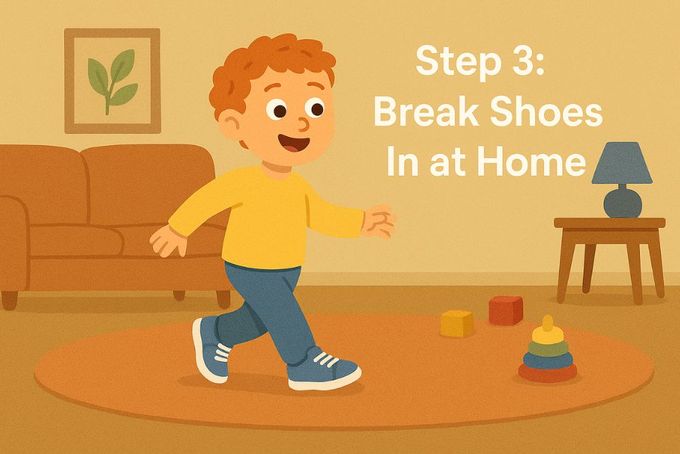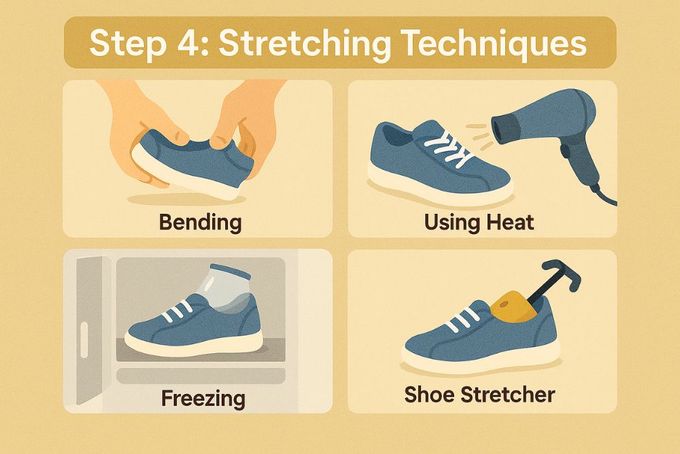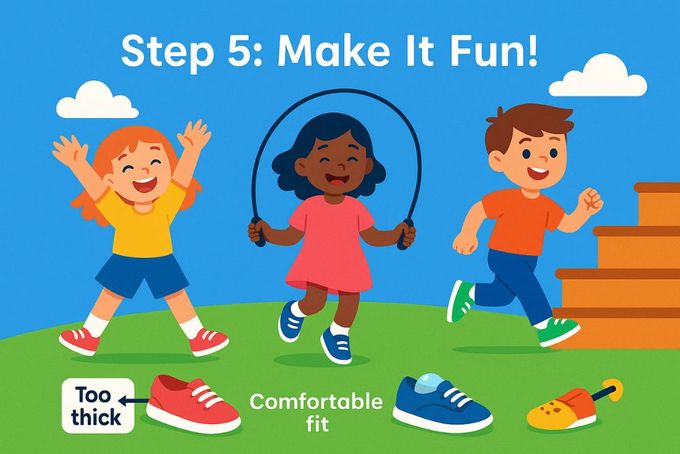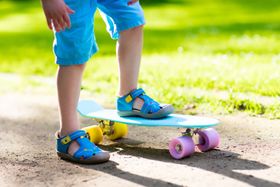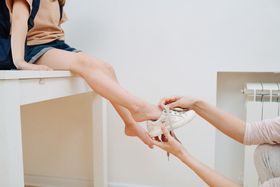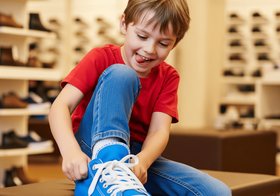5 Expert Tips to Break In New Kids' Shoes (No Blisters!)
Breaking in new shoes doesn't have to be a painful, time-consuming chore. With our expert tips, you can make the wear-in process quick, comfortable, and even fun.
Updated September 26, 2025

Children's feet grow quickly, so it’s important to choose kids’ shoes that fit properly. Ill-fitting shoes can lead to pain, injuries, and even long-term foot problems. By learning how to break in new shoes for kids the right way, you’ll protect their comfort and foot health.
By taking the time to break in new shoes correctly, you can help reduce the risk of these issues and keep your child's feet healthy and happy.
With a little patience and the right techniques, you can simplify the process of breaking in new kids' shoes. Here are our five podiatrist-recommended steps to help you get started:
1. Get the Perfect Fit
A good fit means happy feet, during the wear-in process and after. When buying shoes for your kid, use a simple children’s shoe size guide and head to a store with staff who can measure your little one's feet. This helps you find the best shoes for growing feet and ensures they’ll stay comfortable.
Experts advise leaving some wiggle room, about half a size bigger than your kid's current size. This accommodates growth and natural foot movement. But don't go too big, or the shoes will be uncomfortable and might even cause accidents.
If your youngster is growing fast and their shoes start feeling snug, you might need a quick fix until you can buy a new pair. You can temporarily try replacing the original insoles or gently stretching the shoes a little (see Tip 4).
2. Choose the Right Socks and Insoles
Socks matter too when learning how to break in kids' shoes. The right pair of socks can make all the difference in preventing rubbing and blisters
Opt for thinner socks initially to ensure your child's shoes fit just right. Thicker pairs can make shoes feel tighter and less comfortable, which may lead to rubbing and blisters on your little one's feet.
Generally, sports socks or other shorter styles work well. They don't bunch up and help keep the focus on the shoe's overall fit and support.
Insoles can also make shoes more comfortable and help with posture, but if they're too thick, they can make the shoes feel too constricting. If you're unsure which insoles to choose, consult your child's doctor or podiatrist for personalized recommendations.
3. Break the Shoes in at Home First
Before your child wears their new shoes outside, have them break the shoes in at home. These simple tips for breaking in shoes will reduce the chance of blisters and discomfort, helping you discover how to make kids’ shoes comfortable from day one.
Start by having your kiddo wear the shoes for short periods, like an hour or two at a time, for 3 to 4 days. Let them walk around the house and do their normal activities. This helps them get used to the feel of the new shoes in a safe, controlled environment.
After a few days, you can gradually increase the wearing time. Let your child wear the shoes for longer periods while playing or adventuring at home. Once they feel comfortable, you can take your little one on short walks around the block or to the park.
Most shoes will naturally break in after a few weeks of regular wear. Usually, three to four weeks is enough. But every child is different, so be patient. If your kid says the shoes hurt or don't feel right, take a break and try later.
4. Try Different Stretching Techniques
If you need to break in your child's shoes quickly or they have a persistently tight spot, here’s how to stretch kids’ shoes safely using different techniques.
Bend the Toe Area
If the toe box feels tight, gently bend the shoe back and forth to increase flexibility. Apply pressure with your hands, focusing on the areas that need stretching.
Don't overdo it. Excessive bending could damage the shoe or cause creases. You can also do this for the heel or any other part of the shoe that needs more space.
Use Heat
Carefully apply heat from a hairdryer to make the materials more malleable and stretchable.
Use the dryer on the low heat setting.
Hold it about six inches away from the shoe, and keep it moving to avoid overheating any one area.
Focus on the tight spots, like the toe box or heel. Heat the area for no more than 20 to 30 seconds at a time.
Feel the material frequently. It should warm up, not become uncomfortably hot.
Put socks on your child's feet and then the shoes.
Let the shoes cool completely while your child wears them to allow the material to mould to their feet.
Note: Be cautious not to use heat for too long. It can melt parts of the shoe and cause permanent damage, which could potentially hurt your child.
Try Ice
Fill a sealable plastic bag with water and place it inside the shoe, ensuring it's positioned to stretch the tight spot. Then, put the shoe with the water bag in the freezer for about four to six hours. As the water freezes and expands, it will gently stretch the shoe material.
Once you remove the shoe from the freezer, let it thaw for a bit before removing the bag. Take out the bag completely before letting your child wear the shoes. Any leftover ice could cause discomfort or wet socks.
Invest in Shoe Stretchers
These tools can stretch shoes in specific areas, like the toe box or instep. Insert the stretcher into the shoe and tweak it to apply pressure to the tight areas. For best results, leave the stretcher in place for at least 24 hours.
Note: Follow the manufacturer's instructions for proper use and avoid over-stretching the shoes.
Squeeze the Heel
For some shoes (especially those with a softer heel counter) gently squeezing the back of the heel can help soften the material.
- Place your thumb inside the heel and your fingers on the outside, then apply pressure.
- Repeat this process a few times. This can help make the heel area more flexible and comfortable.
5. Actively Engage Your Kid in the Process
Make breaking in new kids' shoes a fun and engaging experience for your child. Encourage them to participate in various exercises and games that can help stretch and soften the shoes:
Star Jumps and Skipping: These high-energy activities help flex the shoes, allowing them to conform to the foot.
Running and Walking: Have your child wear the shoes while doing basic exercises. These movements naturally help the shoes mould to their unique foot shape.
Toe Bends and Stretches: Guide your child to bend their toes and stretch their feet to loosen up tight areas in the shoes.
Foot Circles: Ask your youngster to make circular motions with their feet while wearing the shoes. This helps stretch the shoe material and improve flexibility.
Stair Exercises: Encourage your kid to walk up and down stairs while wearing the new shoes. This helps stretch the shoe around the ankle and top of the foot.
You can use plasters or blister tape on areas prone to rubbing to prevent blisters and discomfort during these active wear-in sessions.
Final Word: When to Consult a Podiatrist
Breaking in new shoes is essential for ensuring your child's comfort and long-term foot health. If discomfort continues, ask about podiatrist-recommended shoes for kids, which are designed with growth and support in mind.
Remember, every child is unique, and what works for one may not work for another. Pay attention to your child's feedback.
If you're ever unsure about the fit, comfort, or if your child is experiencing persistent pain even after the wear-in period, don't hesitate to seek advice from a professional, like a podiatrist or experienced shoe store staff.
Disclaimer: First Walkers' information is intended for educational and informational purposes related to toddler footwear and feet. We encourage you to consider individual circumstances and consult qualified orthopaedists about specific conditions.
FAQs
Is it normal for feet to hurt with new shoes?
Yes. New shoes often cause discomfort until they mold to your feet. Pain should ease after a few wears.
What shoes are hardest to break in?
Stiff leather shoes, boots, and heels usually take the longest to soften and adjust.
Does heat help widen shoes?
Yes. Gentle heat can make materials like leather more flexible and easier to stretch.
Does using a hairdryer damage shoes?
It can. Excessive heat may crack leather, warp glue, or weaken synthetic materials. Use with caution.
